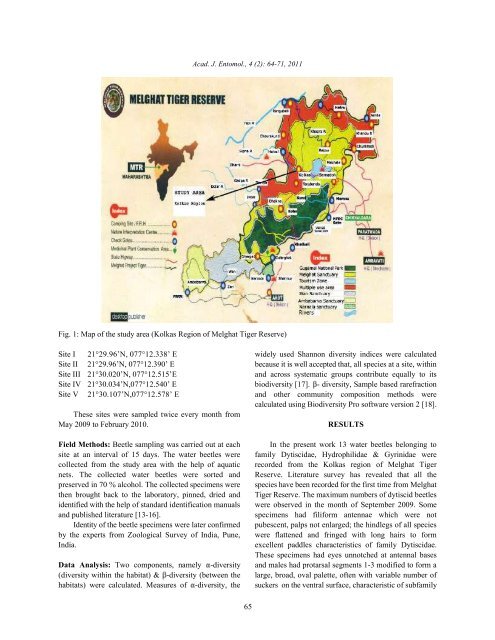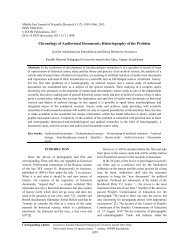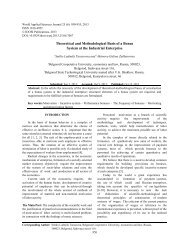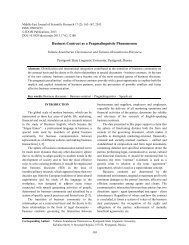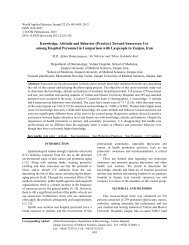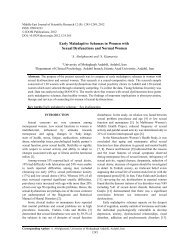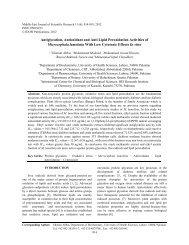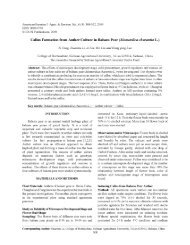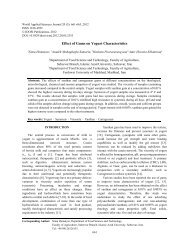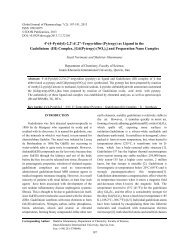Diversity, Abundance and Species Composition of Water ... - Idosi.org
Diversity, Abundance and Species Composition of Water ... - Idosi.org
Diversity, Abundance and Species Composition of Water ... - Idosi.org
You also want an ePaper? Increase the reach of your titles
YUMPU automatically turns print PDFs into web optimized ePapers that Google loves.
Acad. J. Entomol., 4 (2): 64-71, 2011<br />
Fig. 1: Map <strong>of</strong> the study area (Kolkas Region <strong>of</strong> Melghat Tiger Reserve)<br />
Site I 21°29.96’N, 077°12.338’ E widely used Shannon diversity indices were calculated<br />
Site II 21°29.96’N, 077°12.390’ E because it is well accepted that, all species at a site, within<br />
Site III 21°30.020’N, 077°12.515’E <strong>and</strong> across systematic groups contribute equally to its<br />
Site IV 21°30.034’N,077°12.540’ E biodiversity [17]. - diversity, Sample based rarefraction<br />
Site V 21°30.107’N,077°12.578’ E <strong>and</strong> other community composition methods were<br />
calculated using Biodiversity Pro s<strong>of</strong>tware version 2 [18].<br />
These sites were sampled twice every month from<br />
May 2009 to February 2010.<br />
RESULTS<br />
Field Methods: Beetle sampling was carried out at each In the present work 13 water beetles belonging to<br />
site at an interval <strong>of</strong> 15 days. The water beetles were family Dytiscidae, Hydrophilidae & Gyrinidae were<br />
collected from the study area with the help <strong>of</strong> aquatic recorded from the Kolkas region <strong>of</strong> Melghat Tiger<br />
nets. The collected water beetles were sorted <strong>and</strong> Reserve. Literature survey has revealed that all the<br />
preserved in 70 % alcohol. The collected specimens were species have been recorded for the first time from Melghat<br />
then brought back to the laboratory, pinned, dried <strong>and</strong> Tiger Reserve. The maximum numbers <strong>of</strong> dytiscid beetles<br />
identified with the help <strong>of</strong> st<strong>and</strong>ard identification manuals were observed in the month <strong>of</strong> September 2009. Some<br />
<strong>and</strong> published literature [13-16].<br />
specimens had filiform antennae which were not<br />
Identity <strong>of</strong> the beetle specimens were later confirmed pubescent, palps not enlarged; the hindlegs <strong>of</strong> all species<br />
by the experts from Zoological Survey <strong>of</strong> India, Pune, were flattened <strong>and</strong> fringed with long hairs to form<br />
India.<br />
excellent paddles characteristics <strong>of</strong> family Dytiscidae.<br />
These specimens had eyes unnotched at antennal bases<br />
Data Analysis: Two components, namely -diversity <strong>and</strong> males had protarsal segments 1-3 modified to form a<br />
(diversity within the habitat) & -diversity (between the large, broad, oval palette, <strong>of</strong>ten with variable number <strong>of</strong><br />
habitats) were calculated. Measures <strong>of</strong> -diversity, the suckers on the ventral surface, characteristic <strong>of</strong> subfamily<br />
65


